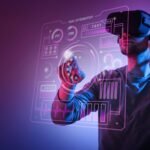
The potential of augmented and virtual reality (AR/VR) to create new forms of art and expression is vast and exciting. With these technologies, artists can create immersive experiences that allow viewers to engage with their work in new and innovative ways.
One of the key benefits of AR/VR for artists is that it allows them to create entirely new environments and worlds that would be impossible to create in the physical world. This opens up new possibilities for storytelling and exploration, and it allows artists to create works that are truly unique and groundbreaking.
Additionally, AR/VR allows artists to create experiences that are interactive and engaging, which can make their work more accessible and engaging to viewers. By using these technologies, artists can create works that are not only visually stunning but also deeply immersive and engaging.
Another potential benefit of AR/VR for artists is that it allows them to create works that are more collaborative and interactive. With these technologies, artists can create experiences that involve multiple people, allowing them to create works that are truly collaborative and engaging.
Overall, the potential of AR/VR to create new forms of art and expression is vast and exciting. As these technologies continue to advance, it is likely that they will play an increasingly important role in the world of art and expression, and they will open up new possibilities for how we engage with and experience art.
One of the key ways that AR/VR is being used to create new forms of art and expression is through the creation of immersive experiences. These experiences allow artists to create digital environments that are rich and detailed, and they can be experienced by viewers using VR headsets or other immersive technology.
For example, some artists are using AR/VR to create interactive installations that allow viewers to explore and interact with their work in new ways. These installations can be installed in galleries or other public spaces, and they can be experienced by viewers in real-time, allowing them to become fully immersed in the artist’s world.
In conclusion, the potential of AR/VR to create new forms of art and expression is vast and exciting. As these technologies continue to advance, it is likely that they will play an increasingly important role in the world of art and expression, and they will open up new possibilities for how we engage with and experience art.





